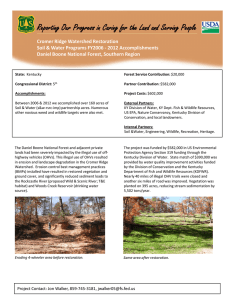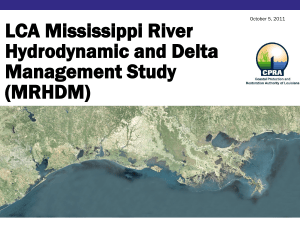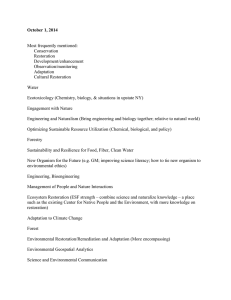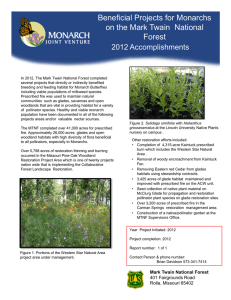A N U L
advertisement
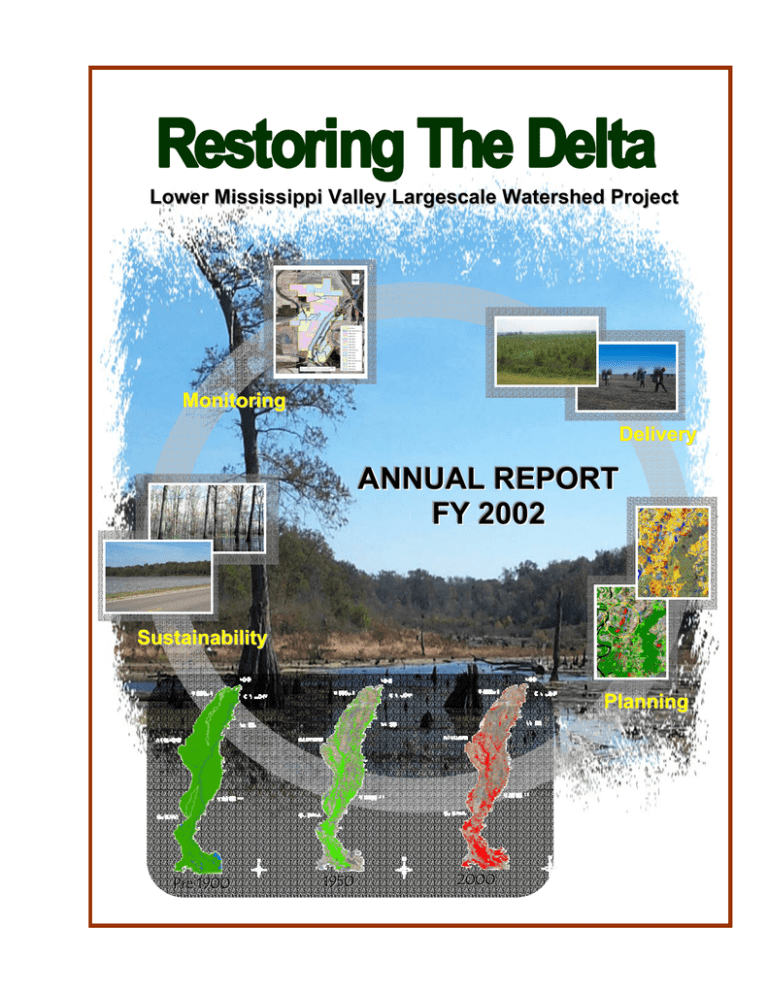
Lower Mississippi Valley Largescale Watershed Project Monitoring Delivery ANNUAL REPORT FY 2002 Sustainability Planning Pre 1900 1950 2000 Restoring The Delta: Partnerships For Sustainable Restoration In the Lower Mississippi Alluvial Valley I. Partnership Overview 2 II. Partnership Goals 3 III. Accomplishments 4 a. Actions 4 b. Environmental Consequences / Outcomes 6 c. Growth 6 d. Products Produced 7 IV. Future Actions and Opportunities 7 V. Partnership Budget 8 VI. Partnership Contacts 8 1 Restoring The Delta: Partnerships For Sustainable Restoration In the Lower Mississippi Alluvial Valley I. Partnership Overview Forested Acres (millions) The Lower Mississippi Alluvial Valley (LMAV) covers more than 24 million acres in parts of seven states extending from southern Illinois to the Gulf of Mexico. Historically, the LMAV was largely bottomland hardwood forests. Flooding of the mighty Mississippi River and its tributaries shaped this land. Rich soils left by these floods produced a vast forested wetland sheltering a great diversity of Lower Mississippi Alluvial Valley wildlife. Settlers in the 1800’s, searching for fertile farmland, cleared forests, starting from the highest and best-drained sites. During the 1900’s flood control efforts straightened and deepened rivers, drained swamps, and encouraged forest clearing on lower, wetter sites. Between 1950 and 1976, approximately one-third of the LMAV’s bottomland forests were converted to agriculture. By the 1980’s less than 20% of the original forest was left. Deforestation and draining of wetland areas resulted in a loss of critical wildlife and fish habitat, decreased water quality, reduced floodwater retention, and increased sediment loads, all of which have contributed to the hypoxic zone in the Gulf of Mexico. The Environmental Protection Agency has identified the Mississippi Delta as an area of significant concern regarding surface and ground water quality. The Lower Mississippi Alluvial Valley is also one of seven high priority areas originally identified in the North American Waterfowl Management Plan. The restoration journey has begun. Numerous agencies and organizations 25 including the Fish and Wildlife Service, 20 Ducks Unlimited, state natural resource agencies, USDA Forest Service, Natural 15 Resource Conservation Service, Corps of Engineers, Environmental Protection 10 Agency, Business Council for 5 Sustainable Development, Delta Council, and Lower Mississippi Valley Joint 0 Venture, are playing a variety of roles in 1600 1820 1937 1947 1957 1967 1977 1990 Year restoring this valuable ecosystem. Bottom Hardwood Forest Acreage in the LMAV Restoring the Delta seeks to catalyze and expand existing partnerships among 2 the public and private interests addressing restoration needs and management challenges in the LMAV. Because over 90 percent of the LMAV is in private ownership, developing economically viable restoration is critical to achieving the biological needs of the LMAV. Simply put…it’s about providing economically and biologically sustainable restoration using Federal, State, and non-governmental agencies, organizations, landowners and companies. Restoring the Delta is being implemented on a state-by-state basis with restoration being delivered by the existing partners programs developed in support of the Lower Mississippi Valley Joint Venture. II. Partnership Goals Restoration work in the LMAV is achieved through satisfying the landowners’ (public or Our goal… private) objectives (biologic, economic or community). Regardless of what motivated 2 million acres of vegetation landowners or managers to restore, the 1 million acres of hydrology ultimate effect is improved watershed health. In order to help achieve significant watershed …over the next 20 years health improvement in the 24-million acre LMAV, the Restoring the Delta partnership has established the ambitious goal of 2 million acres of vegetation and 1 million acres of hydrology over the next 20 years. Our approach is to address issues in three broad areas: restoration, research and education. The restoration component includes project development and delivery on private and public lands that is driven by landowner / manager objectives, rather than programmatic guidelines, and secondly, product development to support the biologic and economic decision-making necessary for project implementation. The intent of the research component is to fully coordinate research activities in the LMAV to help efficiently identify research needs, avoid duplication and provide meaningful information important to delivering the restoration component of Restoring The Delta. The purpose of the education component is to create a comprehensive understanding among private landowners and public land managers about the benefits of biologically and economically sustainable Our approach… restoration at the local scale and Develop biologically and illustrates how local restoration benefits economically diverse, public and private regional restoration objectives. The landscape level restoration. concept is that education leads to Focus research on biologic, motivation. Although all three areas are economic and social restoration issues interrelated and critical to the success of Provide sustainable restoration Restoring The Delta, the primary initial education focus is on the restoration component. 3 The FY 2002 Goals: 1. Develop 1,500 acres of vegetative and hydrologic restoration in the LMAV. 2. Implement Restoring the Delta in the States of Mississippi and Louisiana. 3. Deliver GIS forest change detection product covering the last 50 years in the LMAV to be used as a restoration-planning tool. 4. Conduct a Carbon Sequestration Conference for the LMAV. 5. Deliver a multi-media environmental trading presentation to illustrate the concept of developing an environmental credit project within a watershed. 6. Establish a black willow regeneration study to determine the practical application of using black willow on restoration sites. 7. Double the number of partners in Restoring the Delta. 8. Increase partners’ contributions by 50%. III. Accomplishments A. Actions 1. Developed 750 acres of vegetative and hydrologic restoration and enhancement (Table 1). Of this total, 185 acres of afforestation, 90 acres of hydrologic restoration and 200 of hydrologic enhancement were implemented in 2002. The remaining 275 acres of afforestation will be implemented in Winter 2002/2003. Table 1. Restoration and Enhancement Acres by State. State Arkansas Louisiana Mississippi Action Total Restoration Bottomland Hydrology (Moist Soil) Hydrology (BLH) 185 0 0 0 0 0 275 90 0 460 90 0 0 0 185 0 0 0 0 200 565 0 200 750 Enhancement Vegetative Hydrologic Total 4 Completed design work for Rookery Lake Project on Delta National Forest. This is an 80-acre wetland/waterfowl enhancement project being developed by a partnership between Ducks Unlimited, Forest Service and U.S. Army Corps of Engineers. Implementation is dependent on available funding from the Corps of Engineers in FY03. South GTR Drain 2. Implemented Restoring the Existing Pump Delta in the States of Mississippi and Louisiana. Project delivery in Mississippi will be through the Weir Site Mississippi Partners Program, which includes Ducks Unlimited, Mississippi Department of Wildlife, Fisheries and Parks, Delta Wildlife Foundation, Wildlife Mississippi and the U.S. Fish and Wildlife Service. Project delivery in Louisiana will be through the Louisiana Office of Forestry, Ducks Unlimited and the USDA Forest Service. 3. Formed organizing committee for the LMAV Carbon Conference to be held in November 2003. The organizing committee includes representatives from the USDA Forest Service, Ducks Unlimited, The Conservation Fund, Environmental Synergy Inc., U.S. Geological Survey, U.S. Fish and Wildlife Service, The Nature Conservancy, and Edison Electric Institute. The purpose of the conference is to bring together companies, agencies, organizations and individuals interested in addressing the economic, policy, and research issues that will define an ecologically based carbon sequestration program in the LMAV. The emphasis will be on applied and/or management aspects important to WILDLIFE delivering terrestrial carbon sequestration projects that link the management of the Nation’s greenhouse gas emissions and the restoration of nationally significant fish, wildlife and forest resources. NATURAL FLOOD STORAGE WATER QUALITY 4. In partnership with the USDA Forest Service’s Center for Bottomland Hardwood CARBON SEQUESTRATION Research, initiated a black willow ECONOMICS, POLICIES, AND RESEARCH OF ENVIRONMENTALLY-SENSITIVE regeneration study to determine the TERRESTRIAL CARBON SEQUESTRATION practical application of using black willow on restoration sites. The planting sites were selected, but the willow cuttings could not be obtained due to siltation around the source willow trees. The cuttings will be planted in FY03. 5 B. Environmental Consequences / Outcomes The primary emphasis in FY 2002 was the continued development of partnerships, GIS conservation planning tools, and initial restoration projects in Arkansas, Louisiana and Mississippi. A primary emphasis in FY 2003 will be the development of a comprehensive, regional program to establish indicators and to measure the consequences of the environmental outputs. C. Growth 1. The number of partners participating in Restoring the Delta more than doubled. This included the addition of five nonprofit organizations, three state agencies, three Federal agencies, and two companies (Table 2.). Table 2. Listing of Restoring the Delta Partners Restoring the Delta Partners 2001 2002 USDA Forest Service Ducks Unlimited Lower Mississippi Valley Joint Venture Natural Resources Conservation Service (Ark) U.S. Fish and Wildlife Service (Ark) Arkansas Forestry Commission Arkansas Game and Fish Commission USDA Forest Service Ducks Unlimited Lower Mississippi Valley Joint Venture Natural Resources Conservation Service (Ark) U.S. Fish and Wildlife Service (Ark) Wildlife Mississippi Delta Wildlife Foundation American Forest Foundation The Nature Conservancy Edison Electric Institute Mississippi Forestry Commission MS Dept. of Wildlife, Fisheries and Parks Louisiana Office of Forestry U.S. Fish and Wildlife Service (MS) U.S. Geological Survey International Paper Company Environmental Synergy, Inc. Arkansas Forestry Commission Arkansas Game and Fish Commission U.S. Army Corps of Engineers 2. Annual Restoring the Delta funding has increased 137 percent from the baseline year of FY00. Partner contributions have increased by 100 percent from FY00, with an increase of 28 percent from FY01 to FY02. Funding ($000) 1200 1000 Partners Projected Forest Service 800 600 400 200 0 FY00 FY01 6 Year FY02 FY03 D. Products Produced 1. Completed GIS forest change detection planning tool. This planning tool was developed through a Ducks Unlimited and the USDA Forest Service partnership to evaluate the change in forested area from 1972 to 2001. Because clearing of the LMAV generally occurred from the highest and driest Pre 1900 19 5 0 20 0 0 Forest Cover areas to the lowest and wettest areas in the landscape, this tool will help identify those areas that were most recently cleared (lowest and wettest areas), and therefore, the areas that are a higher priority for restoration. 2. Developed a multi-media environmental trading presentation to illustrate the concept of developing an environmental credit project within a watershed. Credit The product uses the environmental Bundle benefits and costs of various types of Value environmental restoration to illustrate how Tent Polygon “credits” from one portion of a watershed can be traded to offset environmental loss in other parts of the same watershed. This presentation will be used to develop support among stakeholders in the Mississippi Delta for a pilot credit-trading project. Development Hunting Wetlands Carbon Sequestration TMDL Habitat IV. Future Actions and Opportunities In the coming year Restoring The Delta will continue to refine its approach, broaden its partnerships, expand its restoration goals and continue to contribute technical tools, information and assistance to public and private interests in the LMAV. Activities over the next year include: 1. Develop 2,000 acres of vegetative and hydrologic restoration in the LMAV. 2. Implement a comprehensive marketing/communication program for Arkansas, Louisiana and Mississippi. 7 3. Assess GIS technology transfer needs for Arkansas, Louisiana and Mississippi. 4. Develop indicators and outcome analysis program. 5. Make initial partnership contacts in Kentucky and Tennessee. 6. Deliver a GIS forest cover data layer of the 1950’s using historic photos. This will be combined with an existing GIS forest change planning tool that covers the period from the 1970’s to present. 7. Increase the number of partners by 20% 8. Increase partners’ contributions by 20%. V. Partnership Budget Forest Service Partner s 53% 47% Fiscal Year 2002 Total Funding $889,500 VI. Partnership Contacts Gary L. Young, Lower Mississippi Alluvial Valley Watershed Coordinator, USDA Forest Service, (601) 206-5466, gyoung@ducks.org Curtis Hopkins, Director of Conservation Programs, Southern Regional Office, Ducks Unlimited, (601) 206-5445, chopkins@ducks.org Ted Leininger, Project Leader, Center for Bottomland Hardwood Research, USDA Forest Service, (662) 686-3178, tleininger@fs.fed.us 8
